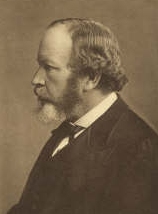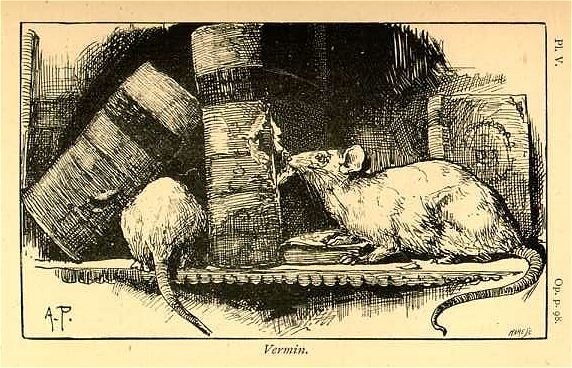
Volume 32 - Autumn 2011
Enemies of Books - Part 7 - Other Vermin
by William Blades

Originally
Published as a serial in 1879 in the August, September and October editions
of the 'Printer's Register'
-"A monthly serial devoted to the interests of printers generally"
First published as a book, with revisions and additions in 1880
BESIDES the worm I do not think there is any insect enemy of books worth description. The domestic black-beetle, or cockroach, is far too modern an introduction to our country to have done much harm, though he will sometimes nibble the binding of books, especially if they rest upon the floor.
Not so fortunate, however, are our American cousins, for in the "Library Journal" for September, 1879, Mr. Weston Flint gives an account of a dreadful little pest which commits great havoc upon the cloth bindings of the New York libraries. It is a small black-beetle or cockroach, called by scientists "Blatta germanica" and by others the "Croton Bug." Unlike our household pest, whose home is the kitchen, and whose bashfulness loves secrecy and the dark hours, this misgrown flat species, of which it would take two to make a medium-sized English specimen, has gained in impudence what it has lost in size, fearing neither light nor noise, neither man nor beast. In the old English Bible of 1551, we read in Psalm xci, 5, "Thou shalt not nede to be afraied for eny Bugges by night." This verse falls unheeded on the ear of the Western librarian who fears his "bugs" both night and day, for they crawl over everything in broad sunlight, infesting and infecting each corner and cranny of the bookshelves they choose as their home. There is a remedy in the powder known as insecticide, which, however, is very disagreeable upon books and shelves. It is, nevertheless, very fatal to these pests, and affords some consolation in the fact that so soon as a "bug" shows any signs of illness, he is devoured at once by his voracious brethren with the same relish as if he were made of fresh paste.
There is, too, a small silvery insect (Lepisma) which I have often seen in the backs of neglected books, but his ravages are not of much importance.
Nor can we reckon the Codfish as very dangerous to literature, unless, indeed, he be of the Roman obedience, like that wonderful Ichthiobibliophage (pardon me, Professor Owen) who, in the year 1626, swallowed three Puritanical treatises of John Frith, the Protestant martyr. No wonder, after such a meal, he was soon caught, and became famous in the annals of literature. The following is the title of a little book issued upon the occasion: "Vox Piscis, or the Book-Fish containing Three Treatises, which were found in the belly of a Cod-Fish in Cambridge Market on Midsummer Eve, AD 1626." Lowndes says (see under "Tracey,") "great was the consternation at Cambridge upon the publication of this work."
 Rats and mice, however, are occasionally very destructive, as the following anecdote will show: Two centuries ago, the library of the Dean and Chapter of Westminster was kept in the Chapter House, and repairs having become necessary in that building, a scaffolding was erected inside, the books being left on their shelves. One of the holes made in the wall for a scaffold-pole was selected by a pair of rats for their family residence. Here they formed a nest for their young ones by descending to the library shelves and biting away the leaves of various books. Snug and comfortable was the little household, until, one day, the builder's men having finished, the poles were removed, and-- alas! for the rats--the hole was closed up with bricks and cement. Buried alive, the father and mother, with five or six of their offspring, met with a speedy death, and not until a few years ago, when a restoration of the Chapter House was effected, was the rat grave opened again for a scaffold pole, and all their skeletons and their nest discovered. Their bones and paper fragments of the nest may now be seen in a glass case in the Chapter House, some of the fragments being attributed to books from the press of Caxton. This is not the case, although there are pieces of very early black-letter books not now to be found in the Abbey library, including little bits of the famous Queen Elizabeth's Prayer book, with woodcuts, 1568.
Rats and mice, however, are occasionally very destructive, as the following anecdote will show: Two centuries ago, the library of the Dean and Chapter of Westminster was kept in the Chapter House, and repairs having become necessary in that building, a scaffolding was erected inside, the books being left on their shelves. One of the holes made in the wall for a scaffold-pole was selected by a pair of rats for their family residence. Here they formed a nest for their young ones by descending to the library shelves and biting away the leaves of various books. Snug and comfortable was the little household, until, one day, the builder's men having finished, the poles were removed, and-- alas! for the rats--the hole was closed up with bricks and cement. Buried alive, the father and mother, with five or six of their offspring, met with a speedy death, and not until a few years ago, when a restoration of the Chapter House was effected, was the rat grave opened again for a scaffold pole, and all their skeletons and their nest discovered. Their bones and paper fragments of the nest may now be seen in a glass case in the Chapter House, some of the fragments being attributed to books from the press of Caxton. This is not the case, although there are pieces of very early black-letter books not now to be found in the Abbey library, including little bits of the famous Queen Elizabeth's Prayer book, with woodcuts, 1568.
A friend sends me the following incident: "A few years since, some rats made nests in the trees surrounding my house; from thence they jumped on to some flat roofing, and so made their way down a chimney into a room where I kept books. A number of these, with parchment backs, they entirely destroyed, as well as some half-dozen books whole bound in parchment."
Another friend informs me that in the Natural History Museum of the Devon and Exeter Institution is a specimen of "another little pest, which has a great affection for bindings in calf and roan. Its scientific name is Niptus Hololeucos." He adds, "Are you aware that there was a terrible creature allied to these, rejoicing in the name of Tomicus Typographus, which committed sad ravages in Germany in the seventeenth century, and in the old liturgies of that country is formally mentioned under its vulgar name, `The Turk'?" (See Kirby and Spence, Seventh Edition, 1858, p. 123.) This is curious, and I did not know it, although I know well that Typographus Tomicus, or the "cutting printer," is a sad enemy of (good) books. Upon this part of our subject, however, I am debarred entering. The following is from W. J. Westbrook, Mus. Doe., Cantab., and represents ravages with which I am personally unacquainted: "Dear Blades,--I send you an example of the `enemy'-mosity of an ordinary housefly. It hid behind the paper, emitted some caustic fluid, and then departed this life. I have often caught them in such holes.' 30/12/83." The damage is an oblong hole, surrounded by a white fluffy glaze (fungoid?), difficult to represent in a woodcut. The size here given is exact.With grateful thanks to Mark Corder and John Gardner
William Blades - printer and bibliographer was born in Clapham, London on the 5th December 1824. In 1840 he was apprenticed to his father's printing business in London and was subsequently taken into partnership. The firm was afterwards known as Blades, East & Blades. His interest in printing led him to make a study of the volumes produced by Caxton's press, and of the early history of printing in England. His Life and Typography of William Caxton, England's First Printer, was published in 1861-1863, and the conclusions which he set forth were arrived at by a careful examination of types in the early books, each class of type being traced from its first use to the time when, spoilt by wear, it passed out of Caxton's hands. Some 450 volumes from the Caxton Press were thus carefully compared and classified in chronological order. In 1877 Blades took an active part in organizing the Caxton celebration, and strongly supported the foundation of the Library Association. He was a keen collector of old books, prints and medals. His publications relate chiefly to the early history of printing, the Enemies of Books, his most popular work, being produced in 1881. He died at Sutton in Surrey on April 27, 1890 manuscripts and birds.
